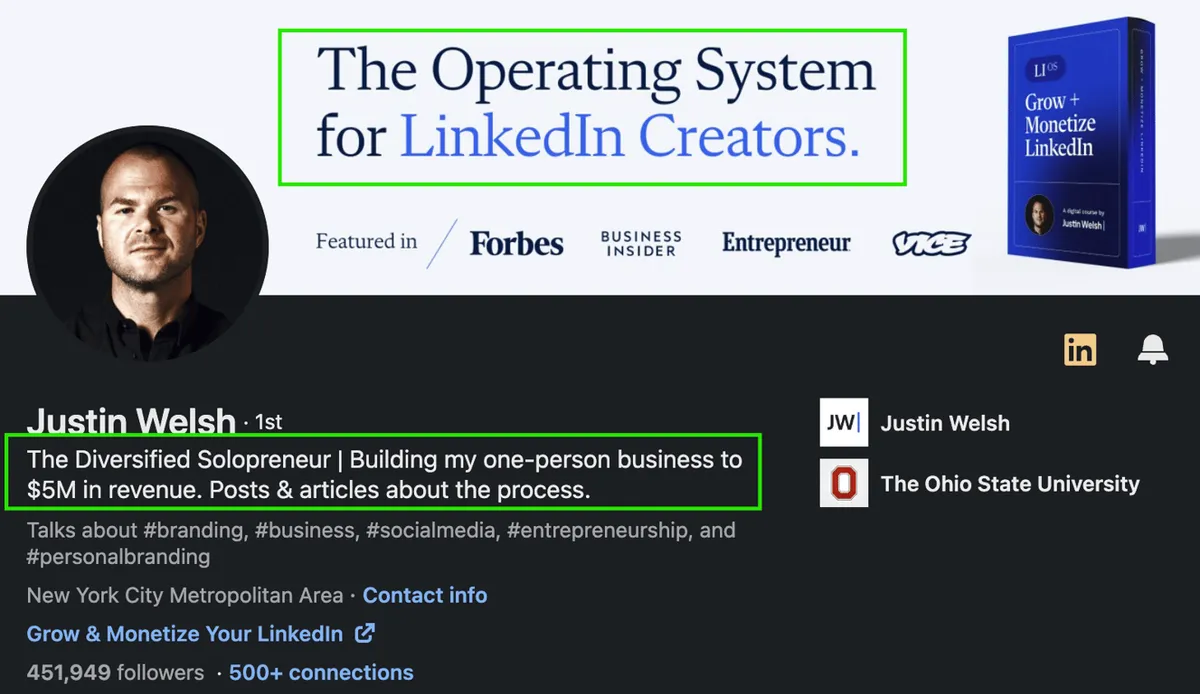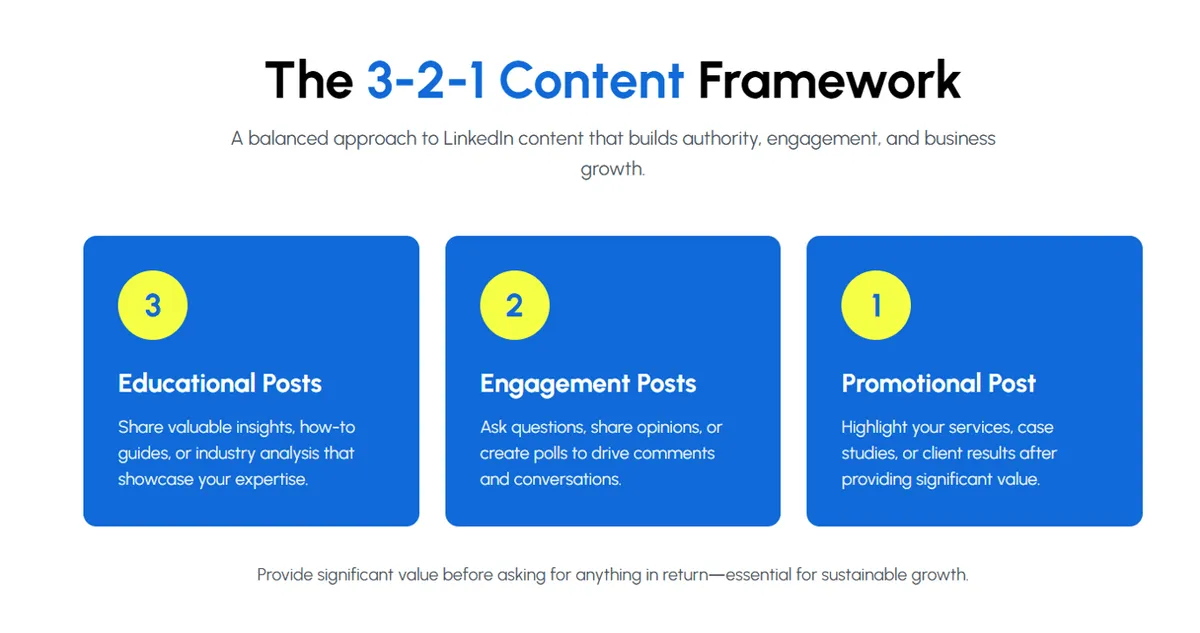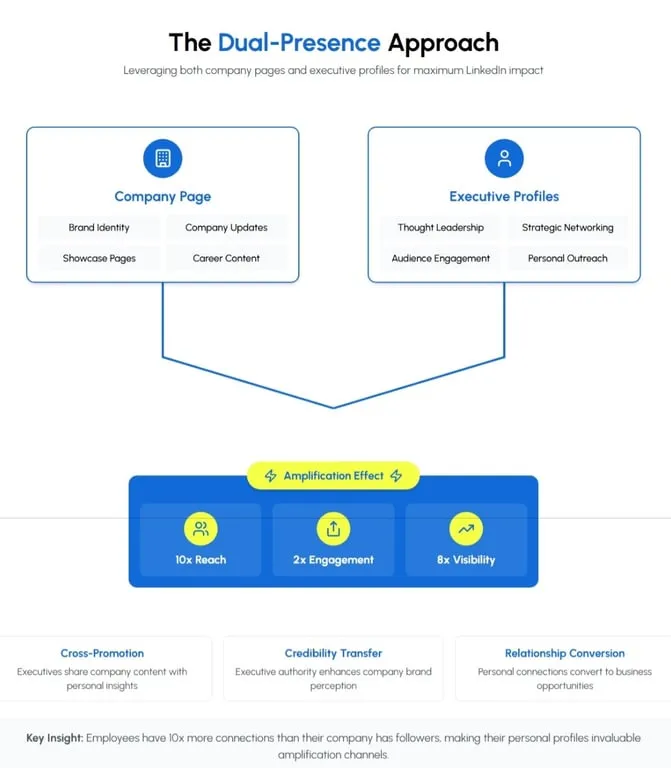As a founder, your attention is constantly pulled in a dozen different directions.
Product development. Team building. Customer acquisition. Fundraising. Operations.
With so many critical priorities, maintaining your LinkedIn presence often falls to the bottom of the list. Yet you've seen firsthand how other founders leverage the platform to attract investors, build strategic partnerships, recruit top talent, and establish industry authority.
The question isn't whether LinkedIn matters for founders-it's how to build an effective presence without sacrificing the time you need for actually running your company.
This guide will show you exactly how to develop a LinkedIn strategy that builds your personal brand while supporting your company's growth, all with minimal time investment.
Why LinkedIn Matters for Founders
LinkedIn offers distinct advantages that make it particularly valuable for founders:
-
4 out of 5 LinkedIn members drive business decisions in their organizations
-
Content from founders typically generates 3x more engagement than company page content
-
40% of investors research founders on LinkedIn before making investment decisions
-
80% of B2B leads generated through social media come from LinkedIn
According to LinkedIn's own research, decision-makers consume an average of 10 pieces of content before making purchasing decisions. For founders, this means the content you share directly influences how potential investors, partners, and customers perceive your company.
The Founder's Dilemma
The biggest challenge most founders face with LinkedIn isn't understanding its importance but finding time for consistent execution. The good news? You don't need to spend hours creating content or endless time scrolling through your feed.
This guide focuses on high-impact strategies that can be implemented efficiently, allowing you to maintain a strong LinkedIn presence with just 15-30 minutes per day.
Building Your LinkedIn Foundation
Before implementing advanced strategies, ensure your LinkedIn foundation is optimized for maximum impact.
Profile Optimization for Founders
Your profile serves as your digital first impression:
-
Professional headline: Go beyond just "Founder at [Company]"-include your mission and impact (e.g., "Founder at TechCo | Helping SMBs Increase Revenue by 30% Through AI")
-
Compelling about section: Tell your founder story-why you started the company, the problem you're solving, and your vision for the future
-
Featured section: Showcase key milestones, media appearances, and company achievements
-
Complete experience: Highlight previous roles that demonstrate relevant expertise
-
Recommendations: Gather testimonials from investors, partners, and team members
For a comprehensive guide on profile optimization, check out LinkedIn Profile Optimization: The Strategic Guide.
Specific elements like your headline are particularly important. For detailed guidance, see LinkedIn Headline Examples and Guide: Stand Out in 2025 With These Proven Formulas.

Content Strategy Framework
Content is the engine that drives LinkedIn success. Implement these proven approaches for founder content.
The 3-2-1 Content Framework
Follow this balanced approach to content types:
-
3 educational posts: Share valuable insights, industry analysis, or lessons learned
-
2 engagement posts: Ask questions, share opinions, or create polls to drive comments
-
1 company update: Highlight product launches, team growth, or company milestones
This ratio ensures you're providing significant value before talking about your company, which is essential for sustainable growth.
For more on effective content formats, see 7 LinkedIn Post Formats Proven to Increase Engagement.

Content Themes That Resonate
For founders, these content themes consistently perform well:
-
Founder journey: Share honest reflections on challenges and victories
-
Behind-the-scenes glimpses: Show how you're building the company
-
Industry insights: Position yourself as a forward-thinking expert
-
Leadership lessons: Share what you're learning about building teams and culture
-
Product development: Provide thoughtful context around your innovation process
One particularly effective approach is storytelling. For guidance, check out Storytelling on LinkedIn: How to Share Backstory Posts for Founder Branding That Attract Your Ideal Customers.
Time-Efficient Content Creation
Implement these approaches to create content efficiently:
-
Batch creation: Schedule 2-3 hours weekly to create multiple posts at once
-
Repurpose existing materials: Transform investor updates, team communications, or product documentation into LinkedIn content
-
Use tools like LiGo: Leverage AI-powered content generation to maintain consistency
-
Create content templates: Develop frameworks for recurring content types
-
Delegate strategically: Train team members to support content creation while maintaining your voice
For a deeper dive into repurposing content, see LinkedIn Content Repurposing: Turning One Idea Into a Month's Worth of Engaging Posts.
Relationship-Building Strategies
Beyond content, strategic relationship building drives business results on LinkedIn.
The 15-Minute Daily Engagement Plan
Implement this daily routine to boost visibility:
-
Respond to notifications (3 minutes): Reply to comments and messages
-
Engage with strategic targets (5 minutes): Comment thoughtfully on 3-5 posts from investors, partners, or industry leaders
-
Connect with new contacts (3 minutes): Send 3-5 personalized connection requests
-
Share valuable content (4 minutes): Post or engage with industry content
This consistent engagement pattern signals to LinkedIn's algorithm that you're an active, valuable community member.
Tools like the LiGo Chrome Extension can significantly streamline this process by helping you generate thoughtful comments directly while browsing LinkedIn.
Strategic Connection Building
Focus on quality connections that align with your business goals:
-
Connect with potential investors and advisors
-
Build relationships with industry influencers and thought leaders
-
Develop connections with potential strategic partners
-
Engage with content from target customers or clients
For guidance on crafting effective connection messages, see LinkedIn Connection Message Templates That Actually Work.
Conversation Transition Strategy
Develop a natural approach for moving from content engagement to business conversations:
-
Identify engaged followers who fit your strategic targets
-
Track their engagement with your content over time
-
Share relevant resources based on their interests
-
Suggest a no-pressure conversation about potential synergies
This approach typically converts at 15-20% compared to 1-2% for cold outreach.
Leveraging LinkedIn for Business Growth
As a founder, your LinkedIn presence should directly support key business objectives.
Fundraising Support
Use LinkedIn to strengthen your fundraising efforts:
-
Share company traction and milestones (without violating any fundraising regulations)
-
Highlight team growth and key hires
-
Demonstrate market understanding through thoughtful industry analysis
-
Connect with and engage potential investors before formal pitches
-
Build relationships with founders who can make introductions
According to research by KPMG, 72% of venture capitalists research founding teams on LinkedIn before taking initial meetings.
Recruitment Enhancement
Attract top talent through your LinkedIn presence:
-
Showcase your company culture and values
-
Highlight team members and their achievements
-
Share your leadership philosophy and approach
-
Engage with potential candidates before formal recruitment
-
Leverage your network for warm introductions to key hires
For more on building your employer brand on LinkedIn, see The Agency Guide to Employee Advocacy on LinkedIn: Start with Your Company Page.
Strategic Partnerships
Develop valuable partnerships through LinkedIn:
-
Identify and connect with potential partners
-
Engage with their content before suggesting collaboration
-
Share content that demonstrates complementary value
-
Use LinkedIn messaging for initial partnership discussions
-
Leverage mutual connections for warm introductions
For more guidance on building business relationships on LinkedIn, check out LinkedIn Engagement: Building Real Connections.
Advanced Strategies for Founders
Once you've established the fundamentals, these advanced approaches can accelerate your results.
LinkedIn Newsletter
Launch a LinkedIn newsletter to build a subscriber base:
-
Focus on a specific theme aligned with your expertise
-
Maintain a consistent publishing schedule (bi-weekly or monthly)
-
Include actionable insights your audience can implement
-
Promote your newsletter through your regular content
-
Cross-promote with complementary newsletters
Newsletters create a direct communication channel with your most engaged followers, bypassing algorithm changes.
LinkedIn Live Sessions
Host regular live sessions to build deeper connections:
-
Conduct monthly "ask me anything" sessions
-
Interview industry experts and partners
-
Provide behind-the-scenes looks at your company
-
Share product demonstrations and updates
-
Answer questions from your community
For guidance on maximizing engagement through LinkedIn Live, see LinkedIn Poll Guide 2025: Create Polls That Drive Engagement and Generate Insights.
Creator Mode Optimization
Enable and optimize LinkedIn Creator Mode:
-
Select 5 topics that align with your expertise
-
Customize your "Follow" button to grow your audience
-
Feature hashtags relevant to your industry
-
Consistently create content around your featured topics
-
Engage with others using the same hashtags
According to LinkedIn data, posts with relevant hashtags receive 30% more impressions than those without.
Balancing Personal Brand and Company Growth
As a founder, effectively balancing your personal brand with company promotion is crucial.
The 80/20 Rule
Follow this guideline for balancing personal and company content:
-
80% personal insights, industry analysis, and thought leadership
-
20% direct company updates and promotions
This ratio ensures you build a strong personal brand while still supporting company objectives.
Cross-Promotion Strategy
Implement systematic cross-promotion between personal and company content:
-
Share key company updates from your personal profile with added context
-
Have the company page highlight founder thought leadership
-
Coordinate content themes between personal and company channels
-
Tag the company in relevant personal posts
-
Encourage team members to engage with both founder and company content
For more on coordinating personal and company LinkedIn presences, see Creating a Content System Between Personal and Company Profiles.

Founder vs. Company Voice
Develop distinct but complementary voices:
-
Personal profile: More conversational, opinion-driven, and experience-based
-
Company page: More informational, benefit-focused, and solution-oriented
This distinction helps maximize the impact of both channels while maintaining authenticity.
For company page optimization, check out LinkedIn Company Pages: The Complete Guide for Businesses.
Tools to Streamline Your LinkedIn Workflow
As a time-pressed founder, leverage these tools to maximize efficiency:
Content Creation and Management
-
LiGo: AI-powered content creation based on your expertise and content themes
-
Canva: Create professional graphics for your posts without design skills
-
Scheduling tools: Plan your content calendar in advance to maintain consistency
Relationship Management
-
LinkedIn Sales Navigator: Advanced search and lead management
-
HubSpot: CRM integration for tracking LinkedIn-sourced leads
-
Contact management systems: Organize your growing network strategically
Analytics and Optimization
-
LiGo Analytics: Track content performance and optimize your approach
-
Shield: Detailed LinkedIn personal profile analytics
-
Performance tracking tools: Connect LinkedIn activities to business outcomes
For a comprehensive overview of LinkedIn tools, see Top LinkedIn Tools for Agency Owners in 2025, Ranked by ROI.
Measuring Success and Optimizing
Track meaningful metrics that connect your LinkedIn efforts to business results.
Key Performance Indicators
Monitor these metrics based on your primary business objectives:
-
Visibility metrics: Profile views, content impressions, follower growth
-
Engagement metrics: Comments, shares, message response rates
-
Business impact metrics: Investor inquiries, partnership opportunities, recruitment leads
-
Company growth indicators: Website traffic from LinkedIn, product inquiries, user signups
For detailed guidance on measuring LinkedIn success, see LinkedIn Analytics: A Complete Guide to Measuring Your Success.
Quarterly Strategy Review
Conduct a comprehensive review every three months:
-
Analyze your top-performing content to identify patterns
-
Review business outcomes generated from LinkedIn activities
-
Adjust your content mix based on what drives meaningful results
-
Set specific goals for the next quarter
-
Identify new opportunities for expansion or optimization
Using LiGo Analytics can help automate much of this analysis, saving you valuable time as a founder.
Case Study: Founder Success on LinkedIn
Let's look at how one founder transformed their LinkedIn presence into a business growth engine:
Founder: Michael, SaaS Startup Founder Challenge: Building visibility for an early-stage company with limited resources
Approach:
-
Optimized profile with clear positioning in the SaaS space
-
Implemented the 3-2-1 content framework focusing on industry insights
-
Established the 15-minute daily engagement routine
-
Started a bi-weekly newsletter on industry trends
-
Created content themes aligned with investor interests
6-Month Results:
-
Profile views: +427%
-
Connection growth: 1,200+ relevant connections
-
Investor interest: 5 inbound inquiries from VCs
-
Strategic partnerships: 3 partnership opportunities
-
Talent attraction: 8 qualified candidates for key roles
-
Brand visibility: 2 speaking opportunities at industry events
The key wasn't any single tactic but the systematic implementation of a founder-focused LinkedIn strategy over time.
Common Founder Challenges and Solutions
"I don't have time for LinkedIn"
Solution: Implement the 15-minute daily routine combined with 2-3 hours of batch content creation each month. Tools like LiGo can help generate quality content aligned with your expertise in a fraction of the time it would take manually.
"My posts don't get enough engagement"
Solution: Review your content strategy against the 3-2-1 framework and ensure you're providing genuine value rather than company promotion. For more guidance, see How to Create Engaging LinkedIn Posts That Drive Results, Not Just Likes.
"I'm not sure if LinkedIn is worth the investment"
Solution: Set clear objectives and track meaningful metrics that connect to business outcomes. For an evidence-based analysis, check out Is Posting on LinkedIn Worth It? Data-Backed Answer.
"I'm worried about privacy while fundraising"
Solution: Focus on thought leadership and industry insights rather than specific fundraising details. Share general traction indicators without violating any securities regulations. When in doubt, consult your legal counsel about what's appropriate to share.
Conclusion: The Long-Term Impact
A strategic approach to LinkedIn creates compounding value over time for founders. Unlike paid advertising that stops generating results when you stop spending, LinkedIn content builds an asset that continues working for you and your company.
The most successful founders on LinkedIn share these characteristics:
-
Consistency: Regular, valuable content that builds momentum
-
Authenticity: A genuine voice that shares both successes and challenges
-
Value-first: Focusing on audience needs before company promotion
-
Strategic patience: Understanding that significant results typically take 6-12 months
By implementing a thoughtful LinkedIn strategy aligned with your business goals, you'll build a powerful platform for thought leadership, relationship development, and sustainable company growth.
For founders who want to streamline this process while maintaining quality, LiGo's theme-based content approach and analytics features provide a significant advantage-reducing the time investment while maximizing results.




